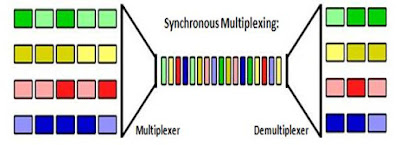You may have heard the term TDM, but what exactly is it?
Time-Division Multiplexing (TDM) is a technique of putting multiple data streams in a single signal by separating the signal into many segments, each having a very short duration. Each individual data stream is reassembled at the receiving end based on the timing.
The circuit that combines signals at the source (transmitting) end of a communications link is known as a multiplexer. It accepts the input from each individual end user, breaks each signal into segments and assigns the segments to the composite signal in a rotating, repeating sequence. The composite signal thus contains data from multiple senders. At the other end of the long-distance cable, the individual signals are separated out by means of a circuit, called a demultiplexer, and routed to the proper end users. A two-way communications circuit requires a multiplexer/demultiplexer at each end of the long-distance, high-bandwidth cable.
If many signals must be sent along a single long-distance line, careful engineering is required to ensure that the system will perform properly. An asset of TDM is its flexibility. The scheme allows for variation in the number of signals being sent along the line and constantly adjusts the time intervals to make optimum use of the available bandwidth.
It looks something like this:

Related Articles ---------